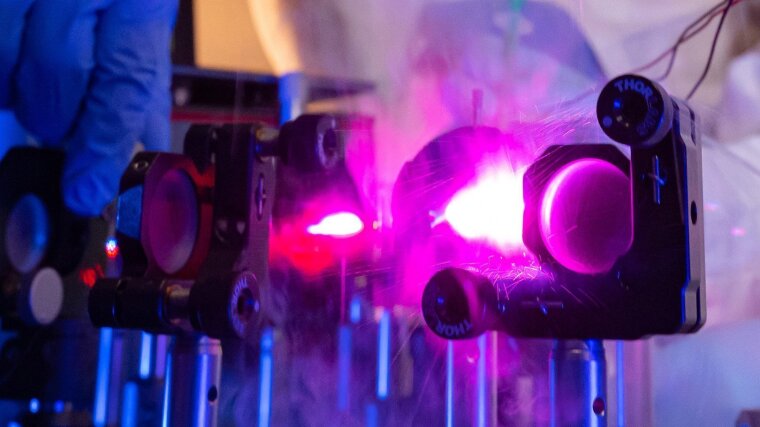
- Light
- Research
Published: | By: Axel Burchardt
We notice the effect of light when the sun warms us and makes the world more pleasant. But light is not only of great importance for humans and nature. Light-driven processes also play an important role in modern technology – for example in data processing or the use of light as an information carrier. Light is also an indispensable tool for microscopy and material production. It drives biological, chemical and physical processes. These make it possible, for example, to switch the structures and function of materials.
The new Research Training Group "PhInt – Photopolarizable Interfaces and Membranes" at the University of Jena will focus on the underlying interactions between light and new materials. The German Research Foundation (DFG) will fund it from 1 September, as announced on 10 May. The research network, for which 5.8 million euros have been applied for over the next five years, will include 24 positions for doctoral candidates.
Interdisciplinary and communicative
In addition to the Friedrich Schiller University Jena, the Jena University Hospital, the Fraunhofer Institute of Applied Optics and Precision Engineering IOF and the Leibniz Institute of Photonic Technology (Leibniz IPHT) are partners in the new research training group, which will be based at the Abbe Centre for Photonics. "PhInt is unique due to the close collaboration between researchers from the fields of materials chemistry, solid-state physics, biophysics, physiology, physical chemistry, theoretical chemistry and physics didactics," says spokesperson Prof. Dr Benjamin Dietzek-Ivanšić.
"This creates new links between the different subject areas, which form the basis for the strongly interdisciplinary training of doctoral candidates at the centre. PhInt acknowledges the communication of research content and science communication. To this end, physics didactics will be directly integrated into the Research Training Group and a collaboration with the German Optical Museum in Jena will be implemented," adds the Professor of Molecular Photonics at the University of Jena, who also heads the "Functional Interfaces" research department at Leibniz IPHT.
Producing photoswitchable membranes and interfaces
Prominent examples of light-driven processes and structures are photosynthesis, light-to-energy conversion in photovoltaics, but also light-driven molecular machines. In all these areas, it is necessary to understand the underlying interactions between light and materials in order to develop new materials with improved functionality. The new PhInt research training group will conduct intensive research into such interactions. The aim is to produce and characterise photoswitchable membranes and interfaces.
The focus is on molecularly thin membranes and the interfaces of solids such as silicon and glass. One focus will be on characterizing the molecular processes across material classes that lead to changes in the macroscopic properties of the materials. In addition, suitable methods will be developed and established to study the processes that take place at the molecular level and sometimes extremely quickly. "Once these processes are understood, new applications will emerge for light-controlled materials, for example in photoswitchable optoelectronics and adaptive photosensors or in the control of cellular signalling processes and drug uptake by light," says Prof Dietzek-Ivanšić, looking far into the future.